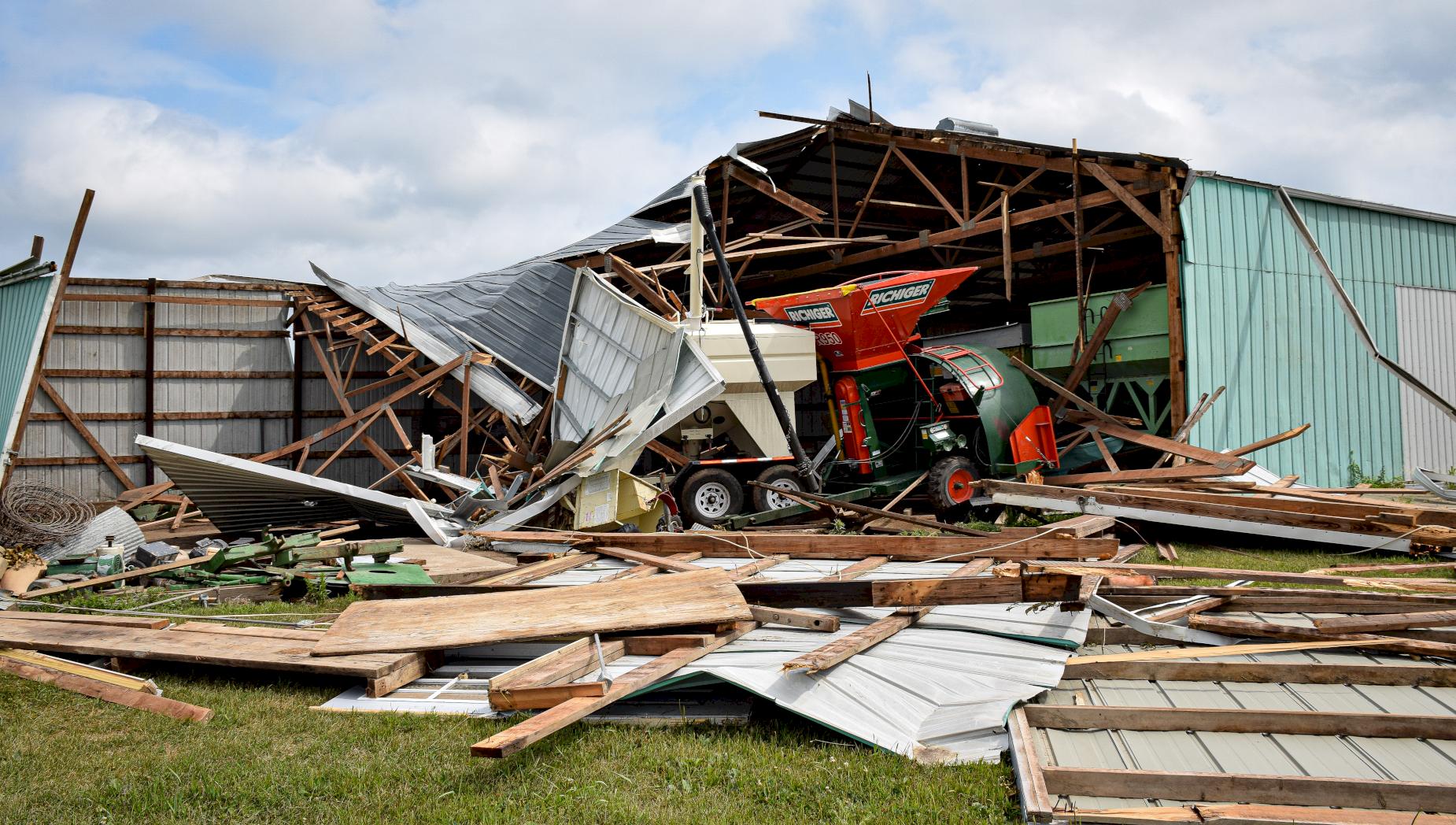
Hail accompanied the high winds during the Aug. 10 derecho and destroyed crops on the Tiefenthaler farm. (Photo courtesy of Tarin Tiefenthaler.)
Farmers working post-derecho to salvage crops, prepare for next growing season
August 20, 2020 | Bethany Baratta
The Tiefenthalers know there won’t be much to this year’s soybean crop. The once waist-high, bushy green soybean plants were stripped to just 3- to 4-inch stems poking up from the soil after hail accompanying the Aug. 10 derecho dashed hopes of a productive premium crop this year.
“For us, this crop’s over,” said Ryan Tiefenthaler, an ISA member who farms near Carroll. “We’re going to salvage what we can, but it’s not coming back.”
Ryan and Tarin Tiefenthaler are premium soybean growers; raising beans for food and seedstock for Syngenta. They’re waiting for guidance from the crop adjuster and Syngenta to determine their next steps.
Soybeans were stripped to the stem in two fields. In two other fields, they were growing soybeans under a rye crop which had been taken off, and soybeans were pulled off as well.
Depending on the decision from the crop adjuster and Syngenta, the crop may be torn out and planted with some sort of cover crop.
“We’ll try to put on a cover with some legumes or a mix to try to pump some nitrogen in the soil before the next corn crop,” Tiefenthaler said.
Half of one corn field—about 125 acres—was destroyed. They connected with a local farmer to sell some for livestock feed. But harvesting the corn has been a challenge; there aren’t many ears, and stalks are breaking as soon as they are hit and falling to the ground.
The story is the same for thousands of farmers across more than one third of the state.
More than 6 million acres severely impacted
Based on MODIS satellite imagery and Storm Prediction Center preliminary storm reports, the Iowa Department of Agriculture and Land Stewardship believes 36 counties in Iowa were hardest hit by the derecho. Within those 36 counties, the storm likely had the greatest impact on 3.57 million acres of corn and 2.5 million acres of soybeans.
The fragility of the crop will be one of several considerations for farmers heading into the fields for harvest this year, say ISA agronomists. Farmers should be in contact with their agronomists and crop insurance agents to properly evaluate the damage and crop potential.
“We are dealing with some yield loss with pods falling off, but how much loss that is remains to be seen,” says Anthony Martin, ISA regional agronomist in southeast Iowa. Southeast of I-80, corn is starting to brown. Damage to soybeans is limited south of I-80, which was outside of the derecho-affected area.
In west central Iowa, ISA agronomist Drew Clemmensen has seen corn crops anywhere from 50% of a field blown over at a 45-degree angle around Highway 141 in northern Guthrie County, to 100% flat and striped of all leaves from hail south of Jefferson area. In that area, it’s evident where the hail hit; half of the soybean plants are stripped of leaves, the backside of the plants has 50% of its leaves, and the plant is still standing.
“A week later we are now just seeing what the true damage is as the severely-damaged crops are starting to die,” Clemmensen said. “We will continue to see this over the next couple of weeks.”
Some fields in the already drought-stressed region were also hit. Any damage or stress increases the potential to take on more stress of insect or disease pressure, Clemmensen said. Because of the plant maturity and the losses expected, treating crops for insects or diseases won’t make financial sense, he said.
In northern Iowa, crops benefited from the rain that accompanied the storm, says ISA agronomist Teresa Middleton. However, there were farmers in central Iowa who experienced significant damage to their crops.
The next steps
Farmers should remain in contact with their crop insurance agents and agronomists to determine the best path forward, Clemmensen said.
“Mother Nature is going to take over and it’s either going to grow or die,” Clemmensen said. “The challenge will be harvesting it in some fashion.”
Martin said farmers should be thinking about the equipment they may need for an anticipated slow, long, difficult harvest. Attachments like Roll-A-Cones may be harder to source closer to harvest, so it’s best to prepare now.
Grain storage availability will also be limited for farmers in the affected areas this year.
Early estimates indicate more than 57 million bushels of permanently licensed grain storage was seriously damaged or destroyed, according to the Iowa Department of Ag and Land Stewardship. The co-ops estimate it will cost more than $300 million to remove, replace or repair the damaged grain storage bins.
Tens of millions of bushels of on-farm storage were also lost during the storm. This may create grain storage challenges as farmers head into the 2020 harvest. In 2019, Iowa farmers harvested 2.6 billion bushels of corn and 502 million bushels of soybeans, according to the USDA National Agricultural Statistics Service (NASS).
Preparing for next year’s crop
Depending on the information received in the next few days, the Tiefenthalers could be planting cover crops in the areas where the crops were destroyed. Something growing is better than nothing, they say.
“We’re focused on the next crop year and how we can make that better by planting a cover crop this year,” he said. “In the middle of August, we have a lot of growing season left for fields to just sit there black.”
Additional resources related to storm-damaged crops, courtesy of Iowa State University Extension and Outreach: https://crops.extension.iastate.edu/storm-damage-resources.
Contact Bethany Baratta at bbaratta@iasoybeans.com.
Back